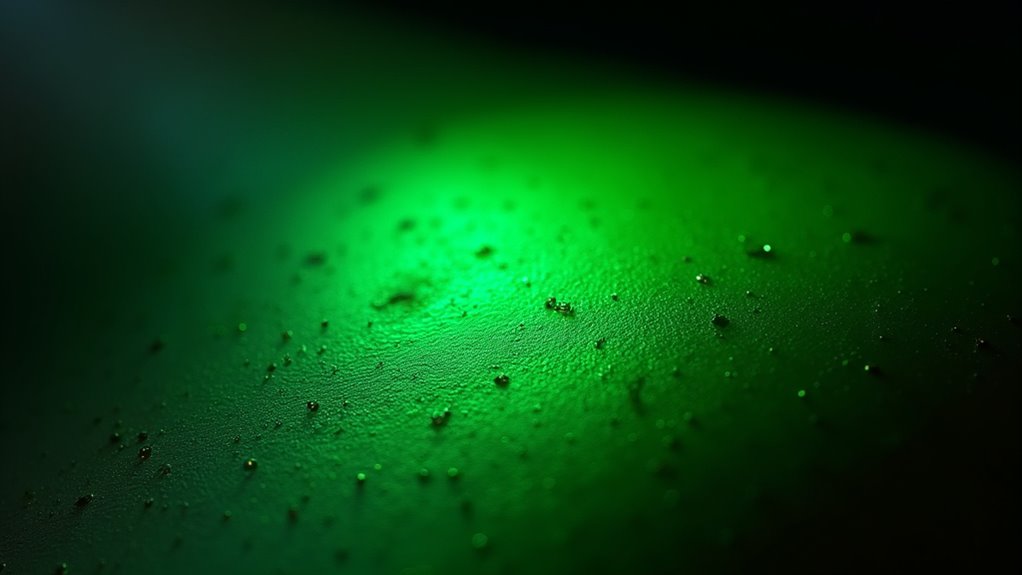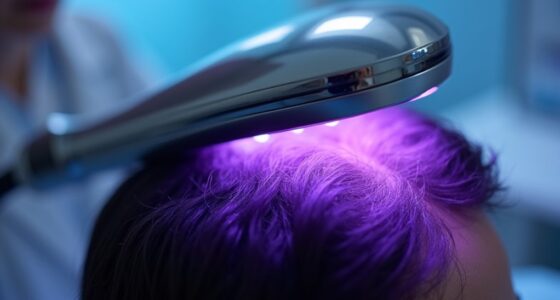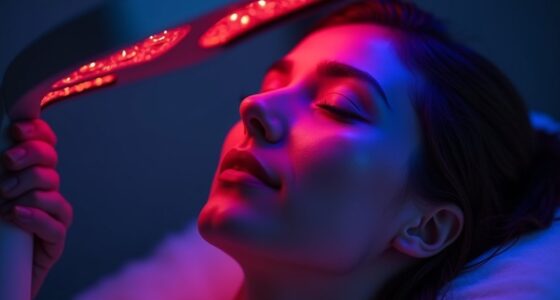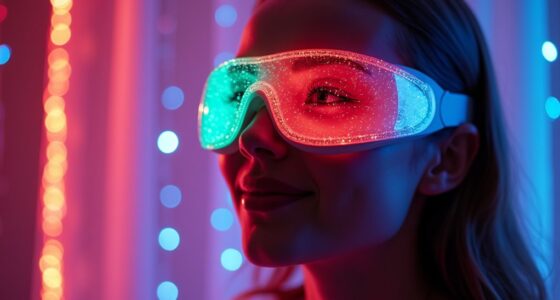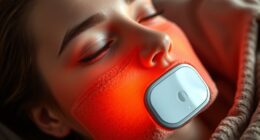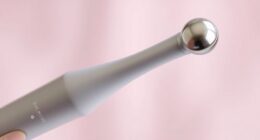Green LED light therapy is marketed as a non-invasive way to reduce hyperpigmentation, but scientific evidence supporting its effectiveness is limited and mixed. While some claim it stimulates skin healing and tone improvement, studies haven’t consistently proven these benefits beyond placebo effects. If you want to understand whether this treatment is worth considering or if it’s just hype, exploring more details can help you make an informed choice.
Key Takeaways
- Scientific evidence for green LED therapy’s effectiveness on hyperpigmentation is limited and mostly anecdotal.
- Current research shows modest, inconsistent results with no conclusive proof of significant skin lightening.
- Unlike proven treatments like laser therapy, green LED lacks large-scale clinical trials confirming efficacy.
- Its non-invasive nature and minimal side effects make it a safe option, but effectiveness remains uncertain.
- Consulting a dermatologist is recommended to evaluate if green LED therapy is a scientifically supported treatment for hyperpigmentation.
How Green LED Light Works on the Skin

Green LED light penetrates the skin’s surface and targets specific cells without causing damage. This is thanks to LED technology, which uses specific wavelengths of light to interact with underlying tissues. When you receive green LED therapy, the light is absorbed by the skin’s chromophores, stimulating cellular processes involved in skin healing. Unlike invasive procedures, LED technology offers a gentle approach, encouraging your skin’s natural repair mechanisms. The green light helps to reduce excess melanin and calm inflammation, making it effective for hyperpigmentation. As the light penetrates deeper layers, it promotes circulation and boosts collagen production, aiding in overall skin rejuvenation. This targeted approach makes green LED therapy a promising option for improving skin tone and texture safely. Additionally, LED tuning techniques can be customized to optimize treatment outcomes based on individual skin needs.
The Scientific Evidence Behind Green LED Therapy
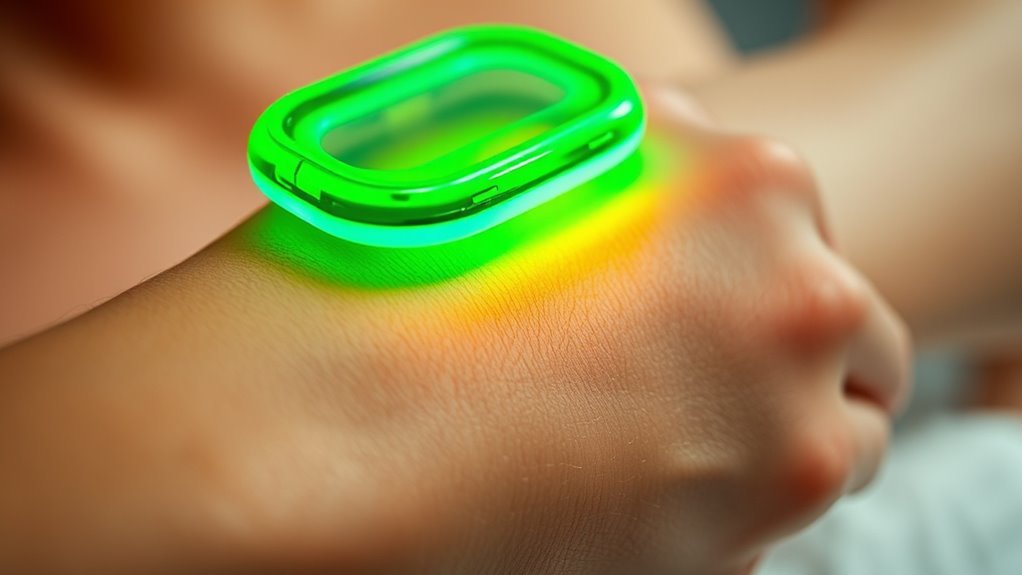
What does scientific research say about the effectiveness of green LED therapy for hyperpigmentation? Currently, the evidence is limited and mixed. Some studies suggest that green LED light may help lighten hyperpigmented areas, but these findings often rely heavily on anecdotal evidence and small sample sizes. It’s important to contemplate the placebo effect, where improvements could result from your belief in the treatment rather than the therapy itself. No large-scale, well-controlled clinical trials definitively prove green LED therapy’s efficacy for hyperpigmentation. While some users report positive results, these accounts don’t replace rigorous scientific validation. Overall, the existing research doesn’t strongly support green LED therapy as a proven treatment, making it essential to approach claims with skepticism until more conclusive evidence emerges. Additionally, understanding the scientific basis behind light therapy can help set realistic expectations for its potential benefits.
Comparing Green LED With Other Light-Based Treatments
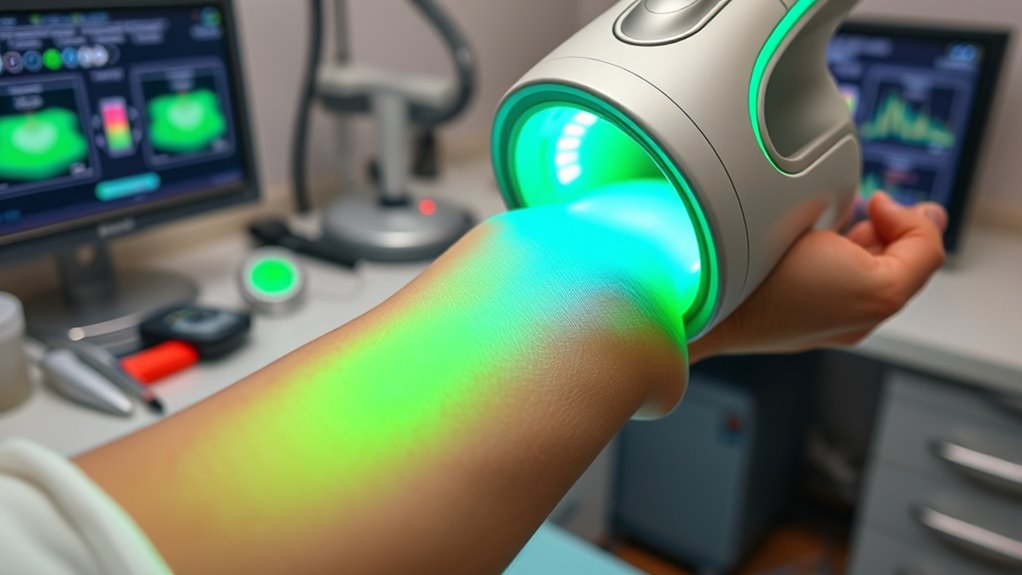
While scientific evidence supporting green LED therapy for hyperpigmentation remains limited and inconclusive, other light-based treatments have a longer track record of use and study. Treatments like IPL (intense pulsed light) and laser therapy are well-established, with proven effectiveness in reducing pigmentation. These alternatives have undergone rigorous clinical testing, unlike green LED, which relies more on anecdotal reports and preliminary studies. Keep in mind, some improvements from light therapies could stem from placebo effects, especially when evidence is lacking. While green LED is marketed as a gentle, non-invasive option, it hasn’t demonstrated clear superiority or consistency compared to traditional treatments. If you’re considering light-based therapies, weigh the extensive research behind proven methods against the limited data for green LED. Additionally, the lack of standardized protocols for green LED treatments makes it difficult to evaluate their true efficacy.
Clinical Studies and Their Findings
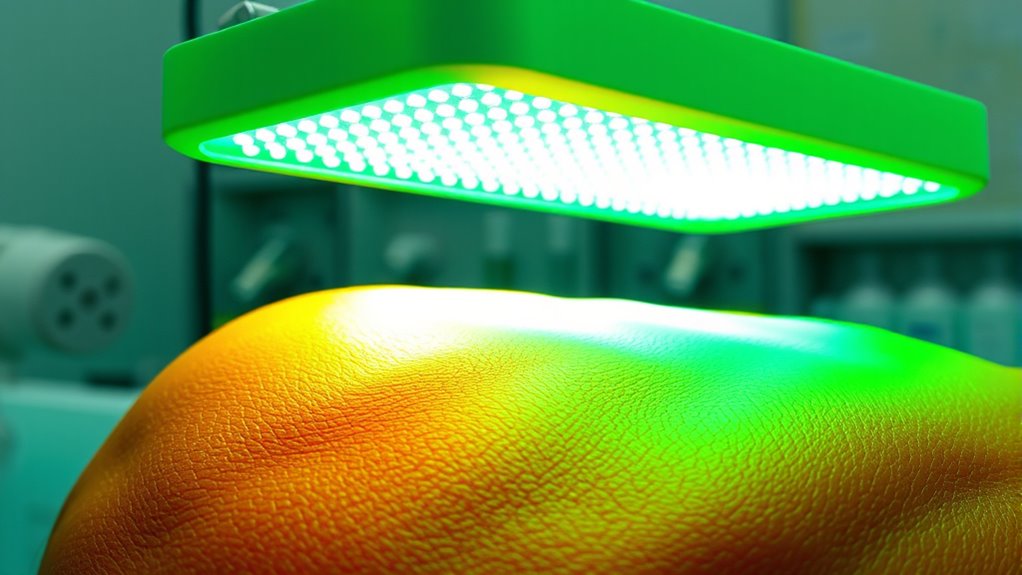
Although research on green LED therapy for hyperpigmentation is still in its early stages, several clinical studies have attempted to evaluate its effectiveness. Some studies show modest improvements, but results often vary. You should be aware that placebo effects and anecdotal reports can influence perceptions of success, making it hard to determine true efficacy. In many cases, participants report skin improvements, but controlled trials sometimes find no significant difference between green LED treatment and placebo. These findings suggest that psychological factors could play a role in perceived results. Additionally, clinical research methods are crucial for accurately assessing treatment outcomes. Overall, current clinical evidence remains inconclusive, emphasizing the need for more rigorous research to establish whether green LED therapy genuinely reduces hyperpigmentation or if observed benefits are largely due to placebo effects.
Potential Benefits and Limitations
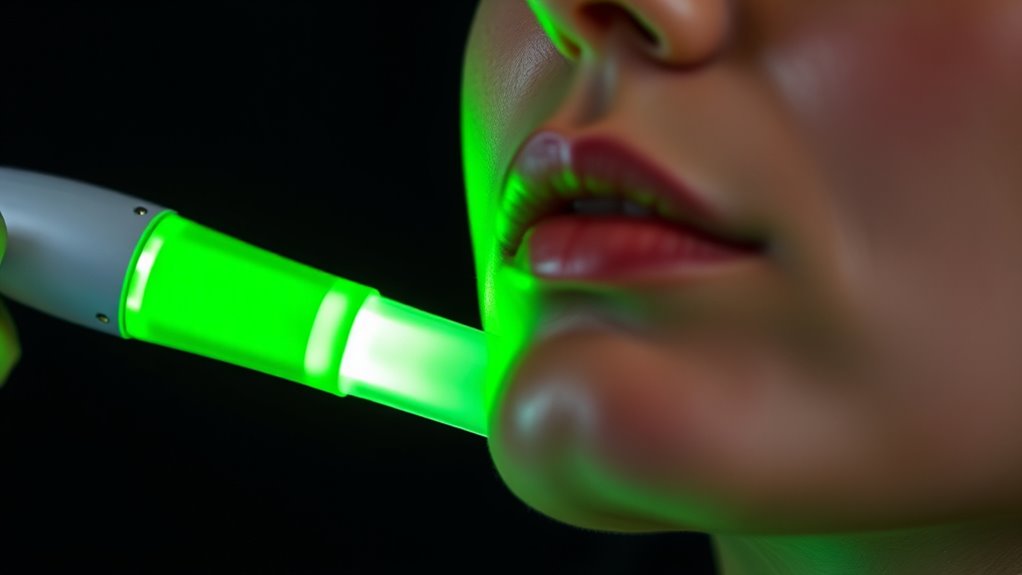
Green LED therapy shows promise as a non-invasive option for addressing hyperpigmentation, but its potential benefits must be weighed against current limitations. Unlike some alternative remedies, green LED treatment may offer a safer and pain-free approach, with minimal downtime. However, the effectiveness varies, and scientific support remains limited, making it hard to guarantee results. Cost considerations also play a role, as multiple sessions can add up, making it less accessible for some. While it’s appealing as a gentle treatment, green LED therapy may not produce dramatic or permanent changes for everyone. It’s important to remember that, at this stage, evidence is still emerging, and what might seem like a promising solution could turn out to be less effective than hoped. Additionally, LED Light Therapy devices vary in quality and efficacy, which can influence treatment outcomes.
Risks and Side Effects to Consider
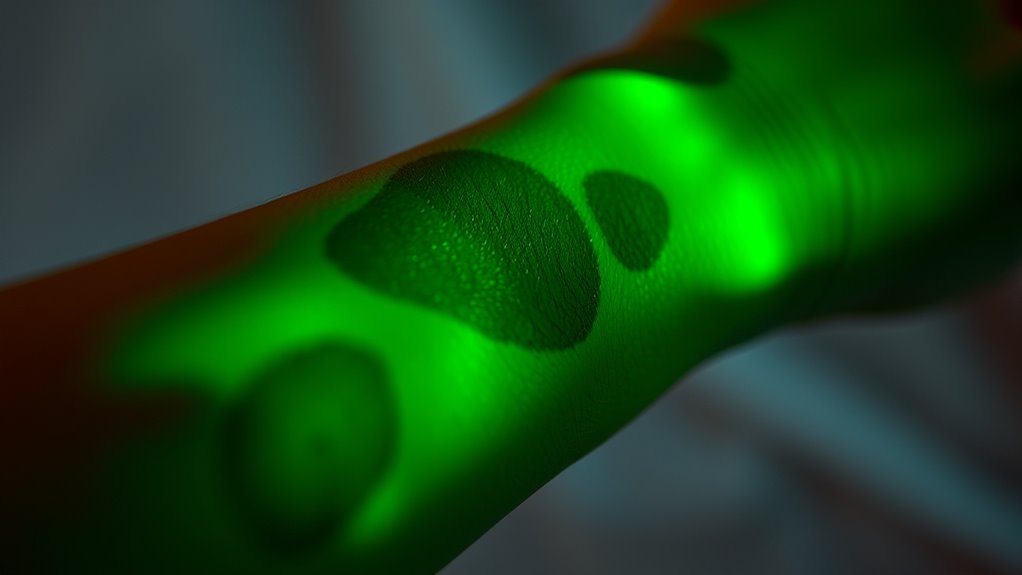
Green LED therapy is generally considered safe, but it’s important to be aware of potential risks and side effects. Some people may experience skin redness, irritation, or dryness after treatment, especially if they have sensitive skin. There’s also a small chance of experiencing temporary pigmentation changes or allergic reactions. These side effects highlight certain safety concerns, particularly for those with skin conditions or allergies. While serious adverse effects are rare, overexposure or improper use could lead to discomfort or skin damage. Always follow recommended guidelines and consult a healthcare professional if you notice any adverse reactions. Being aware of these risks helps you make informed decisions about incorporating green LED light therapy into your skincare routine. Additionally, understanding skin sensitivity can help you better assess your suitability for this treatment.
Professional Recommendations and Expert Opinions

Experts generally recommend consulting a licensed dermatologist or skincare professional before starting green LED light therapy to guarantee it’s suitable for your skin type and concerns. Many professionals emphasize skepticism toward unverified cosmetic claims surrounding this treatment. They advise evaluating the scientific evidence critically, recognizing that some claims lack rigorous validation. Incorporating testing methodologies can help determine the efficacy of green LED therapy through controlled assessments. When considering green LED therapy, professionals often suggest:
- Checking for clinical studies supporting its effectiveness
- Asking about potential interactions with existing skin conditions
- Clarifying expected results and realistic timelines
While some practitioners see promise, many highlight the importance of scientific skepticism due to limited high-quality research. Ultimately, expert opinions stress a cautious approach to green LED light treatments, ensuring safety and avoiding false hope based on exaggerated claims.
What to Expect During a Green LED Treatment Session
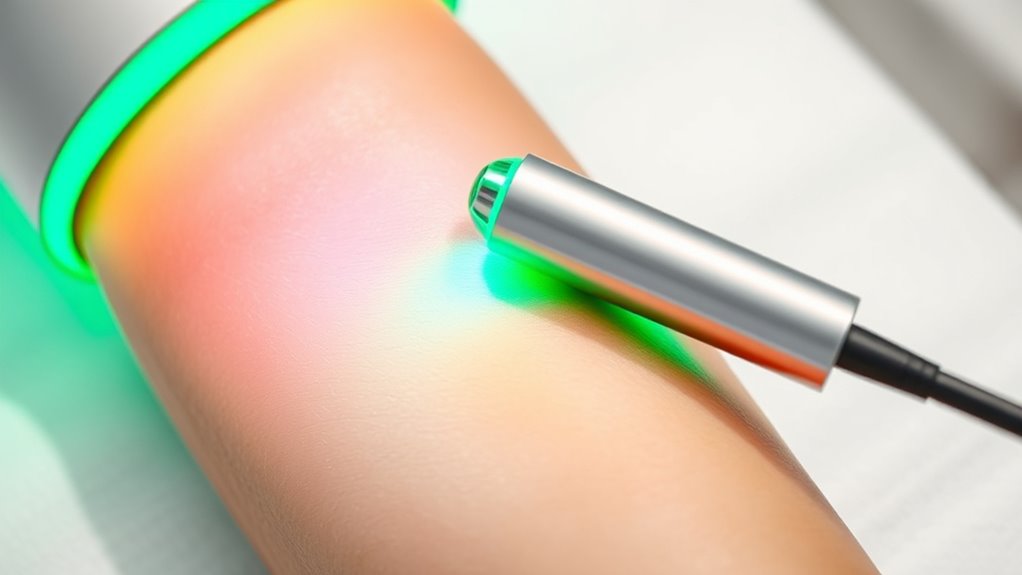
During a green LED treatment session, you can expect it to last around 20 to 30 minutes, with the process feeling gentle and relaxing. You might notice a warm or tingling sensation on your skin as the light works. Right after, your skin could appear slightly reddened or calm, but these reactions typically fade quickly. As the use of LED light therapy becomes more common, understanding its effects and safety measures is essential for effective skin treatment data privacy concerns.
Treatment Duration and Process
A typical green LED treatment session usually lasts about 20 to 30 minutes, depending on your skin’s condition and the area being treated. During each session, you’ll lie comfortably while the device emits gentle green light. The treatment schedule generally involves multiple sessions spaced over several weeks to achieve ideal results. Expect the following during your session:
- Minimal discomfort; some may experience a mild warming sensation
- No need for anesthesia or downtime
- Precise control over session length based on your skin’s response
- The device’s light wavelength is carefully calibrated to target pigmentation without damaging surrounding tissue.
The process is straightforward: the technician adjusts the device, ensuring proper coverage, while you relax. Consistency with your treatment schedule enhances effectiveness, with each session building toward your desired outcome.
Sensations During Session
As the green LED device emits gentle light onto your skin, you may notice a mild warming sensation or slight tingling, but discomfort is usually minimal. During the session, sensations are often subtle, with many patients feeling relaxed rather than bothered. The focus remains on patient comfort, so if you experience any discomfort, you can alert the technician for adjustments. The treatment is designed to be soothing, with no pain or significant sensation beyond gentle warmth. Some individuals may feel a slight prickling or cooling sensation, but these are typically brief and tolerable. Overall, the sensations during the session are mild, making the experience comfortable and easy to endure. This ensures you can relax and benefit from the treatment without distraction. Additionally, being aware of potential skin reactions can help you better prepare for the session.
Immediate Skin Reactions
When the green LED light is applied to your skin, you might notice immediate reactions such as a gentle warm sensation or a slight tingling. These responses are normal and typically subside quickly. Some people may experience minimal discomfort, while others feel nothing at all. It’s important to monitor your skin’s response for allergy concerns, especially if you have sensitive skin.
During the session, you might also observe:
- Mild redness that fades within minutes
- Slight swelling or puffiness in treated areas
- Unusual itching or irritation, which should be reported
If you experience persistent or severe reactions, notify your practitioner immediately. Understanding these immediate reactions helps guarantee a safe and effective treatment.
Making Informed Decisions: Is It Right for You?
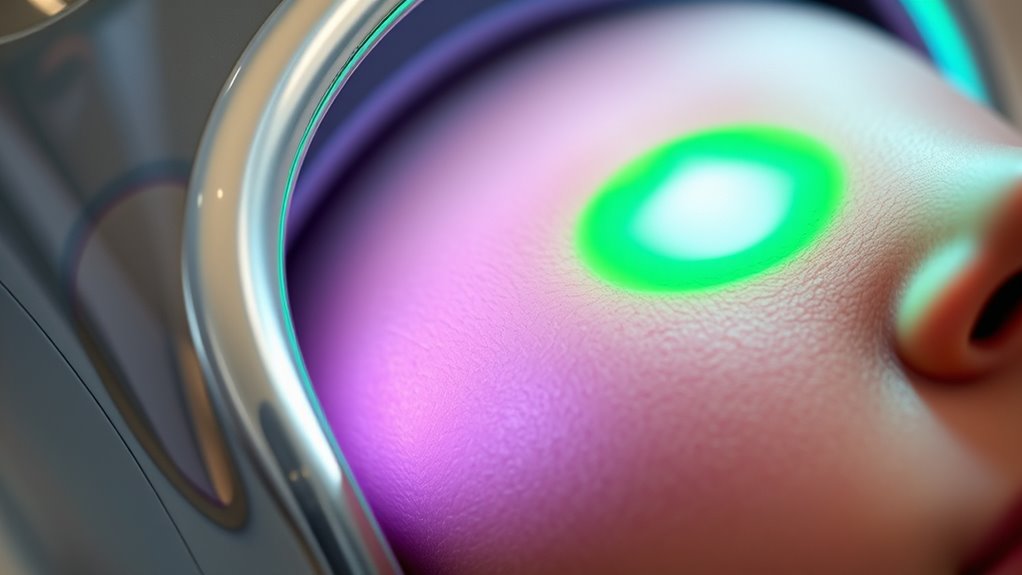
Deciding whether green LED light therapy is suitable for treating hyperpigmentation requires careful consideration of your skin type, goals, and medical history. Evaluate the cost effectiveness of this treatment compared to other options, and consider whether it fits your budget long-term. While some see green LED therapy as a promising, non-invasive approach, it’s essential to explore alternative therapies like topical treatments, chemical peels, or laser procedures. Research their effectiveness, potential side effects, and costs. Consult with a dermatologist to determine if green light therapy aligns with your skin’s needs and your expectations. Making an informed choice involves weighing the evidence, understanding risks, and considering your personal preferences to select the safest, most effective option for you.
Frequently Asked Questions
How Long Do Results From Green LED Therapy Typically Last?
You might wonder how long results from green LED therapy last. Duration estimates vary, but many see improvements lasting several months, especially with consistent sessions. To maintain these benefits, consider ongoing treatments or skincare routines as maintenance considerations. Keep in mind, individual responses differ, so staying consistent and consulting with a dermatologist can help prolong your hyperpigmentation improvements. Regular touch-ups may be necessary to sustain the results over time.
Can Green LED Light Treat Other Skin Conditions Besides Hyperpigmentation?
Think of green LED light as a gentle gardener tending your skin’s garden. Besides hyperpigmentation, it can promote cosmetic benefits like reducing redness, calming inflammation, and supporting skin rejuvenation. You might notice smoother, more even-toned skin as the light nurtures your skin’s natural healing. While it’s not a miracle cure, green LED therapy offers a soothing, non-invasive way to enhance your skin’s health and appearance.
Is Green LED Therapy Suitable for All Skin Types and Tones?
Green LED therapy can be suitable for most skin tones, but your skin tone compatibility may affect treatment efficacy. Lighter skin tones often respond well, while darker tones might need tailored approaches to prevent uneven results. It is crucial to consult with a dermatologist to assess your skin type and determine if green LED therapy is appropriate for you, ensuring safe and effective treatment tailored to your unique skin.
How Does Green LED Compare Cost-Wise to Laser Treatments?
When comparing green LED light to laser treatments, you’ll find green LED generally offers better treatment affordability due to its lower cost comparison. Laser treatments tend to be pricier because of advanced equipment and sessions required. If you’re seeking a budget-friendly option, green LED therapy provides a cost-effective alternative, especially for hyperpigmentation. Plus, it’s less invasive, making it a more accessible choice for ongoing skincare routines.
Are There Any Long-Term Risks Associated With Repeated Green LED Treatments?
Like a cautious traveler, you seek safe roads. Repeated green LED treatments may carry safety concerns, especially for those with skin sensitivity. While generally considered low risk, long-term effects aren’t fully understood. It’s wise to consult with a dermatologist and monitor your skin’s response. Staying informed helps you navigate these treatments safely, ensuring your journey toward clearer skin remains steady and secure.
Conclusion
Green LED light therapy is like a gentle tide that promises to calm hyperpigmentation, but its effectiveness isn’t a guaranteed wave. While some studies show potential benefits, others remain inconclusive. Before diving in, weigh the science against the hype and consult with a skincare professional. Remember, not every treatment is a magic bullet—sometimes, it’s like chasing shadows. Stay informed, and make choices that truly suit your skin’s unique needs.
